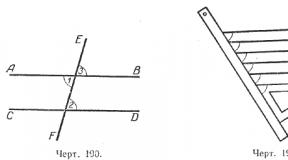When the ability to drink is an art: choose a decanter. Decanter - what is it? Why and where is it used? Wine decanter
Wine needs to breathe. Ideally, if it will breathe in a decanter. There are several basic decanter shapes designed specifically for a particular type of drink. We understand the forms of the decanter and the intricacies of serving wine.
- 1 of 1
On the picture:
What is a decanter for?
Decanters are made of glass or crystal, but this does not mean that their variety depends only on the shape of the vessel. There are decanters with painting, engraving or metal, often silver, overlays.
In the photo: Tray Pm 03799 from the Eichholtz factory.
Let the guilt breathe! A decanter (from French Decanter - to decant, drain) is a wine decanter for aeration (oxygenation) of wine. After the bottle has been uncorked, most varieties of wine require a short respite: poured 20-30 minutes before serving into an open carafe, the wine "breathes", changing its properties. Connoisseurs say that the taste of wine in the decanter becomes brighter.
Draft - no! Unlike bottles (where mostly dark or colored “bottle” glass is used), a wine decanter is made exclusively from clear glass, crystal and crystal. A decanter allows you to carefully pour wine into glasses, controlling its purity and getting rid of sediment - the main problem of aged wines.

- 1 of 1
On the picture:
Manufacturers include decanters—often handmade—in some of their wine glass collections. They allow you to control the sediment in aged wines, and the young wine to be saturated with oxygen.
How to choose the right decanter?
What does the shape of the decanter say? The shape of the vessel directly depends on what kind of wine it is intended for. For young wine, it is recommended to use a decanter with a wide bottom and a funnel neck, a decanter for aged wine - with a spherical bottom, so it is easier to get rid of sediment in a noble drink. Decanter in the form of a vase or amphora is designed for rose wines. For white and rosé wines, carafes are usually made with a lid - such varieties are not supposed to breathe too much.

Comment on FB Comment on VK
Also in this section

The most important working tool of any cook - a knife - is selected according to certain rules. Chef Alexander Ermakov talks about the types of knives, the quality of steel and the correct sharpening?

A beautiful service can be passed down from generation to generation. Or you can buy a set of simple but cute dishes and enjoy using it at least every day. What to look for when buying?

Buying a ready-made set of knives is easier than collecting the necessary inventory one by one. What knives should be in the minimum and advanced sets? What can you do without, and what will you absolutely need?

Summer. Asphalt melts, young ladies bare their shoulders and knees. The interior also wants to be freed from excess textiles. We have collected some inspirational ideas for you - how to set the table without a tablecloth.

These knives have not yet entered into widespread use. And meanwhile, with some tasks they cope better than steel. What can and cannot be cut with ceramics, how to care for it and from whom to buy?

The most sought-after accessory: for centuries, the candlestick was indispensable in everyday life, today it is indispensable in the interior - it is given its due by designers, consumers and antique dealers.

Modern candlesticks and candelabra are used more often for interior decoration than for their intended purpose. Let's take a closer look at what products are currently on sale.

The knife, without exaggeration, can be called the very first cutlery. Usually we use one device during a meal, but according to the rules of etiquette, each dish should have its own knife.

Pepper and salt shakers are not only functional products, but also decorative elements of the dining table. They make the taste of the dish more expressive, and complement the serving. What is the history of these items?

Do you want to create a festive mood, surprise your loved one? Have breakfast in bed. Beautiful serving, properly chosen stylish and practical table will help you with this.

The first mention of spoons was recorded as early as the 3rd millennium BC. e. Since then, there have been a great many of them. Sometimes it is not easy to understand what this or that variety looks like and where it should lie on the table.

The fork became a cutlery much later than the knife and spoon - in the 9th century. But they began to use it actively only from the 17th century: it was believed that eating with hands and a spoon is much more convenient. Now the fork has become

The eternal question "what to do with an empty wall?" It is easy to solve if you have beautiful dishes in your house. Hang your plates on the wall! It is not at all necessary to bring souvenir saucers with views of the city from the trip.

In stores you can find dishes from various materials. Each type has its own advantages and disadvantages. What is the difference between faience and porcelain dishes, and what is the advantage of ceramic products over porcelain?
2015-11-28
Date: 28 11 2015
Tags:
Good afternoon dear readers! On the eve of the New Year holidays, when it is impossible to do without a glass of good wine, I would like to invite you to discuss some of the processes of drinking this wonderful drink, which is called "the sun in a glass." To be, so to speak, closer to the finished wine, let's talk about the last stages of the process. A special type of glass decanter called a decanter is used to clear wine from suspension. You ask: “What is a decanter?”Now we will figure out what this mysterious vessel is for many.
What is a decanter and what is it used for?
Decanters are glass carafes used in the process of decanting wine. Decantation is the process of pouring wine from a bottle into a specialized vessel . Decanting or decanting solves the following issues:

A little about the history of the decanter
Surprisingly, wine lovers used such vessels even before our era. Then decanters were made of ceramics. These were well-known amphorae. They were filled with wine before serving. Archaeological excavations give reason to assert that glass decanters were willingly used in Ancient Rome. After the crowds of barbarians staggered and then defeated the Roman Empire, the production of glass vessels fell sharply. Glassware began to be replaced by bronze, copper or porcelain. The center of glass production slowly moved to Venice. Local artisans improved the glassmaking process with great success. Their glass was highly valued and of excellent quality.
The Venetians thought of making an unusual bottle with a wide bottom and a long neck. Such ecapacity began to be usedto purify wine. The decanter, which has just such a shape, is still considered traditional and is used everywhere.
Which wines should be decanted
Basically, decantation is subjected to:
- Red and white matured wines - to remove sediment.
- Unripe "young" red wines with pronounced tannins - to soften the tart taste of expressive, unripe tannins, so that the wine reveals its delicious full aroma and characteristic taste.
- Young white wines - for ventilation.
- Red wines of many years of aging are decanted only by highly professional specialists, and even then, if they are sure that they will not “break” the wine by disturbing it. With inept movements, so old wine can simply be “killed”.
Which decanter shape is preferred for certain wines and why
The shape of the decanter is of great importance during decanting. Currently, decanters of the most diverse, sometimes even bizarre forms are being produced. Ripe reds and whites wines that have been aged for many years naturally contain sediment (most commonly "tartar"). Of course, the sediment that has fallen to the bottom of the bottle once again proves that the drink has a long history, but at the same time, the appearance still deteriorates somewhat. This is where a decanter comes in handy. Decanters that are designed for such wines are always made with a narrow neck, and the base is made of a spherical shape.  This form includes decanters in the form of a duck , similar to the classic "pot-bellied" decanter with a glass stopper.
This form includes decanters in the form of a duck , similar to the classic "pot-bellied" decanter with a glass stopper.
Funnel-shaped decanters with a wide base are intended for young red wines that have not yet shown their potential. The poured wine should be located no higher than the level of the widest part of the container. During pouring, the wine mixes with atmospheric oxygen, which allows the taste and aroma to unfold. Decanters for such wines are produced without corks and lids. The taste and aroma of the poured drink directly depends on the area that is in contact with atmospheric oxygen. 
Now let's look at what happens in the decanterfor
white
guilt
. In white young wines, sediment is practically absent. They are decanted for the sole purpose of mixing oxygen with wine, which ennobles the aroma, “opening”, as experts would say. The neck in this case is funnel-shaped, the lower part is not limited to a certain shape, the main thing is that it is not too narrow. 
Decanting Technology
For young wines
In a clean decanter intended for the decantation process, pour a little wine, rinse the vessel with it, letting it drain along the walls. Then pour into a separate glass. This is done to eliminate odors. Now you can pour the wine in the same way as it is usually poured into a glass.
For mature wines
Pouring mature wine requires special skill. Sometimes a bottle a day before serving a noble drink is brought from the cellar, where it was stored in a horizontal position, placed vertically so that the sediment particles sit on the bottom. Then, after the required time, decanting is performed. In other cases, the bottle is carefully and carefully carried out of the wine cellar in a horizontal position, then placed in a special basket to allow sediment particles to settle. After 15 minutes, pour the wine. This must be done with a confident smooth one-momentary movement so that the poured wine does not pour back into the bottle. 
Decanter Tricks
In order for the precipitate to separate to the greatest extent, an experienced bartender has small tricks. The bottle that will be opened must be placed vertically for a while. This will help the resulting sediment to fall to the bottom. When serving, it would be nice to light a candle. What will it give? If mature wine is poured, a candle helps not to miss the moment, the sediment approaching the neck. The bartender will immediately stop the spill. If unripe wine is poured, then the candle will give the case a special chic.
How to care for a wine decanter
- The decanter cannot be washed in a dishwasher; specialized equipment and detergents are on sale.
- Use only special, fragrance-free detergents.
- When a dark coating appears on decanters for red wine, pour a little table vinegar into them, throw a couple of pinches of rice or barley. Gently rock the container from side to side. You will soon see how effectively your decanter has been cleaned. Rinse it with boiled water several times, wipe it from the outside with a glass cloth with microfiber.
- Wipe wipes periodically wash and boil.
- It is necessary to dry decanters on rods installed at an angle, and preferably vertically.
My remarks

I think that as a result of our conversation today, dear readers, we have in general figured out what a wine decanter is and what it is for. In order to make the celebration stylish, it is absolutely not necessary to go to a restaurant. Using interesting and useful wine accessories at home, we can bring the customs of the best restaurants into our home.
Good luck with your shopping and happy mood before the holidays! See you soon!
Always yours Irina.
In order to drink wine according to the canons of wine tasting, it is not necessary to go to a restaurant, you can achieve this at home using the right accessories. Let's try to understand such a concept as a decanter for wine, how to choose it, use it, and take care of it. The history of this vessel is rooted in the distant past, even the Romans liked to drink wine from beautiful elongated jugs - amphoras. He is popular even now.
So what is a wine decanter? This is a special vessel, usually made of glass and having the following proportions: narrow part, wide part, neck. A jug or decanter for wine is a decanter.
Why decant wine

By decanting the drink, we achieve several goals:
- It's beautiful and aesthetic. Wine poured into an exquisite vessel looks much more interesting on the table than an ordinary bottle.
- When transfusing a liquid from a decanter, you can also use a suspension in the wine.
- Saturation of the drink with atmospheric oxygen. This will help the wine to reveal its unique bouquet and rich color.
Which wines should be decanted
This process has a different effect on different types of wines.
Important! Do not take on the decantation of rare wines. This work can only be done by experienced specialists, and they will not always undertake such a procedure. The risk of significantly degrading the quality of the product is very high.
If you are not the owner of rare wines, feel free to experiment!

The most suitable drinks for this procedure are wines made from red grapes, but decanting white wine is also possible.
- Aged after decantation will get rid of tartar and sediment accumulated during storage;
- Young decanted wine will become less tart in taste due to the reduction of tannins in the drink, this will happen due to aeration;
- will become even softer and more tender in taste;
- Ripe white and red wines will be saturated with atmospheric oxygen;
- It is possible to decant sparkling wines in order to rid them of excessive gas content.
Decanting Technology
There are rules that govern how to properly decant wine.
 The mature drink is poured from the bottle into a narrow-necked decanter. This is done with confident, gentle movements so that the sediment does not get inside the vessel.
The mature drink is poured from the bottle into a narrow-necked decanter. This is done with confident, gentle movements so that the sediment does not get inside the vessel.
Young wine, unlike mature wine, is sent to the vessel as sharply as possible, so that the drink is enriched with atmospheric oxygen.
There are some subtleties that should not be forgotten, namely:

How to choose the right decanter
 When purchasing a decanter, it is important to consider a number of points:
When purchasing a decanter, it is important to consider a number of points:
- Why do we need it, for what type of wine;
- What is the container made of. The best properties of decanters are recognized for crystal, although a well-made vessel of glass will also do;
- The important factor is the price. Prices on the market range from 1,500 rubles. up to 1,000 dollars.
- And of course the design. A special carafe can be functional and decorative with various inserts and embellishments.
- When purchasing, inspect the decanter for damage to the vessel, including the absence of seams, chips, cracks and other defects.
- The surface must be absolutely smooth.
- The neck must be the correct shape.

- Thin brush for washing.
- A special stand for drying the decanter in a vertical position.
How to care for your wine decanter
In order for the decanter to serve us for a long time, it is necessary to properly care for it.

Before decanting, the decanter flask must be put in order.
- The decanter is strictly forbidden to be placed in the dishwasher, wash it only by hand.
- Do not use aggressive cleaners that have a strong odor. This may affect the quality of the drink.
- For washing, use a special thin brush and soft linen napkins.
- It is recommended to dry the decanter upside down.
- If plaque is found on the walls of a special decanter, it is necessary to pour a small amount of table vinegar into it, pour a few pinches of any cereal (preferably rice, pearl barley, buckwheat). After that, carefully shake the decanter until the plaque completely disappears. Drain everything carefully, rinse several times with boiled water.
There is a wide range of decanters on the market today. It is worth seeing the decorative decanters for Riedel wines, depicting various animals. Such a vessel would be a wonderful gift. Spiegelau, Vivo products are made of crystal glass.

You should not buy decanters from unknown manufacturers, as the risk of buying goods from low-quality glass is too great.
 Why table wine has such a name and how it ...
Why table wine has such a name and how it ...The culture of drinking wine involves the use of devices such as wine decanters. A simple and original solution to emphasize and fully reveal the whole gamut of flavors and smells of the proposed drink. Currently, the sommelier of an elite restaurant will definitely offer the client the process of decanting the wine he ordered.
Purpose
The essence of the chemical process of decantation is the release of liquid from suspension. It's no secret that over time, old aged wines "acquire" sediment. In order to avoid spilling wine into a glass, the liquid is first poured into a special vessel - a decanter. In shape, it resembles a flask from a chemistry classroom.
Wine decanters have been used since ancient Rome. True, initially they served more for beauty. Exquisite vessels looked much better on the tables than bulky earthenware jugs.
Today, such a specialized decanter for wine performs three main functions:
- helps to clean the product from sediment;
- saturates the liquid with oxygen;
- instills a culture of wine consumption, tunes in to get real pleasure from the taste and smell of the drink.
It is interesting to watch the process, especially if the specialist knows his business and presents it as a sacrament or an ancient ritual:
- first pour no more than 50 grams and rinse the walls of the decanter (this wine is poured into a special container);
- then the wine is poured using a wax candle - the flame allows you to see when the sediment "fits" to the neck of the bottle, at which point the pouring stops.
Even the pouring of liquid has its secrets: a wine decanter must be filled up the wall. The bottle is tilted at such an angle that the liquid flows smoothly without creating a reverse movement.
The form
There are two types of vessels. They have different purposes:

There is one rule for all drinks: the wine poured into the decanter must be consumed on the same day.
Material
There are few materials from which you can make a quality decanter:

- high-quality glass, without any impurities, transparent, the absence of a pattern will help emphasize the dignity and beauty of the wine;
- pure crystal is used for the production of expensive, sometimes exclusive models.
Cupronickel, silver, gold are used to decorate the vessel. They make coasters, handles, lids. Any finish should not interfere with the contemplation of the drink. Experts believe that the corrugated or colored surface of the carafe can hopelessly spoil the taste of wine.
The use of wood, even the most expensive and rare varieties, is unacceptable. Wine decanters cannot be ceramic or earthenware.
Care
Special dishes require special care. The presence of fingerprints, chips or the presence of foreign odors is unacceptable on the vessels. For washing do not use active chemicals and do not use a dishwasher. Before washing, purified water is prepared, and only special neutral detergents.

Wine decanters are washed by hand with a professional brush. The special type of bristles do not fall out and do not remain on the glass surface. Outside wipe with special napkins. The vessel is dried and stored on a stand in an inverted position at an angle, always separately from all other dishes.
Choice
The crystal decanter is considered the best. The price of such a product is quite high, and the presence of precious metal trim can increase it to several thousand dollars. This decanter is perfect for a gift.
A simpler vessel will cost 15-20 dollars. More complex forms of a decanter will cost $50-70. All of them are made of high quality glass and perfectly perform their main functions. For home use, choose a decanter according to your taste and financial capabilities.
It is known that the taste characteristics of alcohol-containing products largely depend not only on the quality of the raw materials used and the subtleties of the manufacturing process, but also on the method of supply. To allow the wine to fully reveal its best qualities, experienced sommeliers use special techniques in their work with the use of various accessories. One of the main ways to improve the organoleptic properties of alcohol is decantation - the slow pouring of liquid from a bottle into a special glass vessel. Consider what a magical wine decanter is and how to choose the right one depending on the type of drink.
Purpose of the accessory
What is better a classic dusty bottle or a mystical jug, everyone decides for himselfMany connoisseurs of noble wines are interested in the question of what a decanter is and why it is needed. In fact, this is a kind of elegant decanter made of food glass, which has a special shape and a certain ratio of sizes in its narrow and wide parts. A special container for serving alcohol began to be used at the dawn of winemaking, when they noticed that pouring a product from a barrel or bottle can significantly improve its taste, color and smell. Now the main goals of decanting include the following:
- suspension removal and;
- additional oxidation of unripe grape fermentation products;
- aeration or weathering, allowing the liquid to be saturated with oxygen;
- giving the process of serving alcohol a special elegance and aesthetics.
Wines for decanting
Not every drink is designed to perform a transfusion ritual. The following products can be safely decanted:

 Decant, experiment!
Decant, experiment! - young grape nectars to get rid of sediment;
- ripened red and white wine for oxygenation;
- excessively tart fermentation products of red grape varieties to soften the taste;
- filtered white wines for extra airing;
- some sparkling drinks to remove excess gases and stabilize.
There is no point in carrying out the procedure for cognacs, liqueurs and inexpensive wine products that have undergone tough processing and filtration before bottling.
Important! Decanting aged rare white and red wines can lead to their destruction and a significant deterioration in taste characteristics.
How to choose the shape of the decanter
In the process of desludge or aeration, the shape of the decanters used plays an important role. Consider which vessel to choose for each type of decanted liquid.

To improve the properties of the drink during decantation, the following rules must be observed:

Accessory care
In order for the decanter for serving wine to serve for a long time and better help to reveal the character of the drink, it should be properly looked after:
- washing is carried out only by hand, without the use of a dishwasher;
- it is forbidden to use dishwashing detergents with a pronounced odor, which can be absorbed into the walls of the vessel and spoil the properties of alcohol when served;
- for better cleaning, it is recommended to use thin silicone brushes with a long thick pile;
- it is necessary to dry the containers in a vertical position or at an angle, putting on a special pin;
- before serving, the glass surface must be carefully polished with a linen napkin;
- when a dark coating appears on the inner walls, it is recommended to clean the decanter with a mixture of table vinegar and any cereal (rice, pearl barley, buckwheat).



















